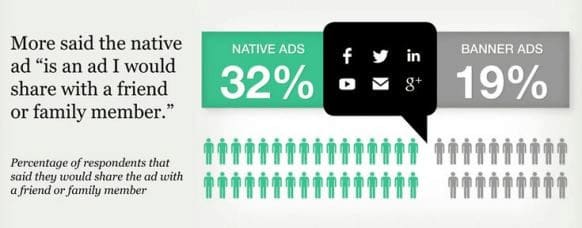This post was most recently updated on July 30th, 2019
Native advertising allows brands to advertise their content within the publisher’s site in a non-intrusive way. When clicked, it directs to another page within the site and not away from the site.
Although the implementation of native advertising is far less common and more or less complicated than that of the banner ads, it’s actually a basic concept. It is hosted on the publisher’s site, in the same template where organic content is, but authored by an advertiser.

Native advertising is non-conventional, not-so-new revenue stream to some publishers and advertisers. It generally gets 3x more engagement rates than the traditional standard banners as visitors tend to read native ads as opposed to banners which are commonly ignored. They are more often than not, perceived as part of the organic content which therefore earns more clicks and attention.
Related Read: How to Maximize Revenue from Native Ads
Some examples of native ad networks are Nativo, Sharethrough, and Publish2. Publishers should choose brands active in producing high quality branded content and the audience segments they target versus what your site reaches (e.g. Technology – Intel, Financial – American Express).
Related Read: Top Ad Networks in 2014 per Vertical
Here are some quick tips on how to monetize native ads:
In the traditional banner advertising, an impression is counted every time an ad is shown to a user. It doesn’t work the same way in native advertising. Advertisers would like their content on the publisher site to be consumed by the users.
Try negotiating a flat rate for every instance that the full article is viewed or every time the article summary shows up.

While strategizing to make these native ads blend well with your site content, keep in mind the FTC guidelines on labeling your ads accordingly. Anything that you’re paid to publish on your site must be transparent to your audience. Otherwise, you will not only commit a violation against the FTC (this could be dangerous!) but ultimately destroy your hard-earned credibility among users.
There is no other way to best target ads to your readers but through being relevant. Make sure to create a significant amount of content or text in your website so the ads that show up are of much relevance to your audience segment and website vertical.
Additional Tips:
- Your advertiser partners must try using original imagery instead of company logos to boost CTR.
- When creating promo offers, advertisers are advised to experiment with questions or statements that can impact target audience’s lives.
Native ad placements may take different forms — stream or feed (e.g. Facebook, Twitter), Gallery (e.g. Pinterest), Grids (e.g. Etsy).
Don’t forget that native advertising also works on mobile. It may also come in a form of video, text or other media.
What is ‘Viral lift’? How do you measure it? Essentially, it answers the question: ‘How viral is your content?’
It is the ratio of shares to clicks. For instance, a visitor shares your content on a social media network, a click is counted when somebody clicks that shared link and lands on your site. The more clicks a shared link is able to generate, the higher is the viral lift percentage.
This type of analysis allows you to see the type of content people are most interested in after seeing the links on social networking sites. You are then able to make editorial decisions based on the numbers.
Native advertising has been a buzzword lately – and why not? Lots of publishers are earning good revenue from them. Still, the bottom line lies on how well you manage the ads alongside your organic content.
When it comes to website monetization, you can reach out to MonetizeMore to help you with your native ads strategy and ad inventory management.
Related Reads:
image credit: marketingpilgrim.com, cloudfront.net

Kean Graham is the CEO and founder of MonetizeMore & a pioneer in the Adtech Industry. He is the resident expert in Ad Optimization, covering areas like Adsense Optimization,GAM Management, and third-party ad network partnerships. Kean believes in the supremacy of direct publisher deals and holistic optimization as keys to effective and consistent ad revenue increases.

Paid to Publishers
Ad Requests Monthly
Happy Publishers



10X your ad revenue with our award-winning solutions.